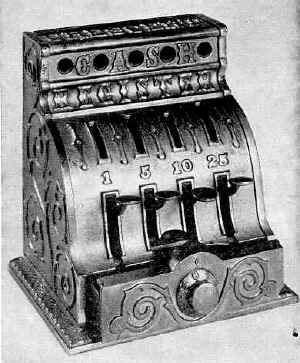Some Thoughts On Mechanical Banks
by F.H. Griffith - HOBBIES Magazine - July, 1977
 In thinking back to the Bicentennial, it would seem that there was
only one really good mechanical bank made to commemorate this important event. This is the
limited edition Betsy Ross Bank for sale to collectors or anyone who chose to buy one.
This puts the bank in a little different category than the Mary Roebling or the Sears
Uncle Sam. Neither of these banks were available to the public, or to collectors for that
matter. The three banks share one thing in common, they are mechanical and as mechanical
banks are collectible in the modern category, but not the same had they been sold in
stores to the general public. And their intent was never as a child’s toy, which is
all right, of course, but does put them in a little different category as compared to
commercially produced mechanical banks sold in stores to the public in general.
In thinking back to the Bicentennial, it would seem that there was
only one really good mechanical bank made to commemorate this important event. This is the
limited edition Betsy Ross Bank for sale to collectors or anyone who chose to buy one.
This puts the bank in a little different category than the Mary Roebling or the Sears
Uncle Sam. Neither of these banks were available to the public, or to collectors for that
matter. The three banks share one thing in common, they are mechanical and as mechanical
banks are collectible in the modern category, but not the same had they been sold in
stores to the general public. And their intent was never as a child’s toy, which is
all right, of course, but does put them in a little different category as compared to
commercially produced mechanical banks sold in stores to the public in general.
It is surprising that more banks were not produced for the Bicentennial. There was one very nice still bank on the market. It consists of a hollow cube of lucite with a metal Liberty Bell suspended inside. The bell has a clapper and rings when the bank is shaken. As advertised a coin dropped in the bank rings the bell by hitting it. This brings up a point — it is very definitely not a mechanical bank. There is no mechanism involved, no mechanical parts, and no action or animation. There is only sound — the ting of the bell. There have been those who feel that a bank like this should be classed as a mechanical bank. There is absolutely no way to justify this and it is only a still bank, nothing else.
During the Centennial of 1876, a cast iron Liberty Bell was produced with a small bell inside. Depositing a coin caused the inside bell to ring as the coin hit the bell. This is a still bank and has always been properly classified as such. There is no way to justify its being mechanical any more than the one produced for the Bicentennial.
There are mechanical banks that play music such as the Treasure Chest Music Bank. These banks have mechanisms and the coin, when deposited, starts the mechanism causing the music to play. This definitely qualifies them as mechanical — they have operating moving parts and the coin activates the musical action.
To carry the ringing of a bell a step farther, there is a mechanical bank known as the Crescent Cash Register Bank. This is cast iron and it rings a bell. However, it has mechanism inside and when a coin is placed in the proper slot and the respective lever pressed, the mechanism causes the bell to ring. The levers will not work or ring the bell unless a coin is used in its proper slot: penny, nickel, dime and quarter. This bank fully qualifies as a mechanical, it does not register the money and is not, therefore, a registering bank. It is a very attractive, well made cast iron cash register type bank. It is circa 1890 to 1910. The bank is nickel plated, well cast, and has a combination drawer for removal of coins. It is No. 268 in the numerical classification. The drawer is shown slightly open in the photo.
* * *
Every now and then someone asks when the 1935 date will be advanced — this separating modern from old or antique mechanicals. There should be a spread of 45 to, better still, 50 years, and nothing is to be gained by advancing the date in the near future. Few banks were produced between 1935 to 1941. Then World War II caused practically all production of mechanical banks to stop and nothing really got started again until the late 1940’s and early 1950’s.
